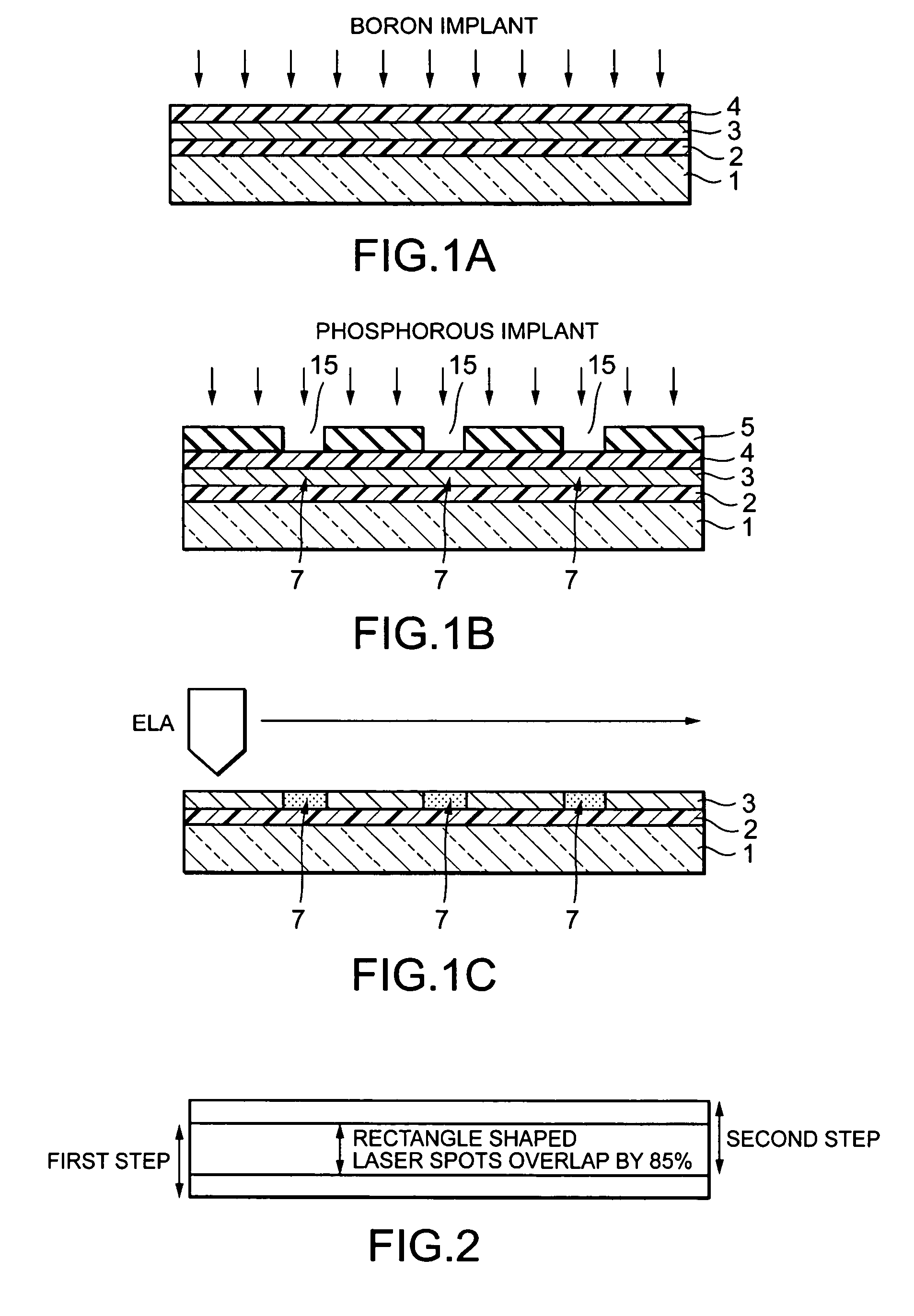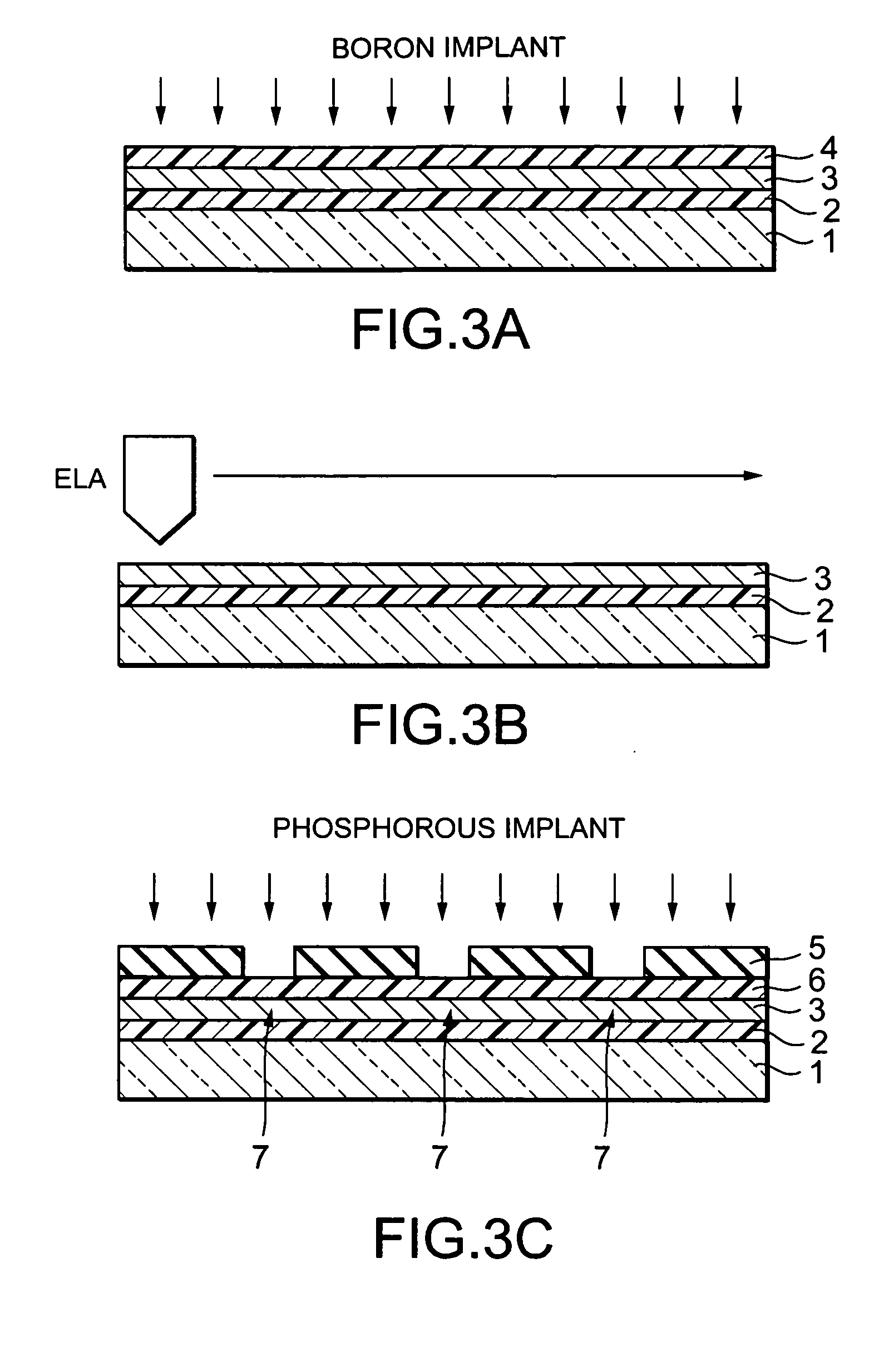Method for manufacturing thin film transistor
a thin film transistor and manufacturing method technology, applied in the direction of crystal growth process, polycrystalline material growth, chemistry apparatus and processes, etc., can solve the problem of imposing a substantial processing burden on the circuit design
- Summary
- Abstract
- Description
- Claims
- Application Information
AI Technical Summary
Benefits of technology
Problems solved by technology
Method used
Image
Examples
first embodiment
[0018] A method for manufacturing a thin film transistor according to the invention will be explained in detail below. FIGS. 1A, 1B and 1C are cross sectional side views of a TFT substrate constituting a liquid crystal panel and illustrate a part of process steps of a method for forming a thin film transistor on a transparent insulating substrate, in the order of process steps. Furthermore, FIG. 2 is a plan view illustrating how the TFT substrate is subjected to a multi-step radiation process, in which rectangle-shaped Excimer laser radiation is used for manufacture of thin film transistor.
[0019] First, an amorphous silicon film 3 is deposited over a transparent insulating substrate 1 via an insulation film 2. Then, for example, a boron dopant is implanted into the entire amorphous silicon film 3 via the insulation film 4 to adjust the threshold voltage of an N-channel transistor (refer to FIG. 1A).
[0020] Thereafter, a resist film is coated over the amorphous silicon film 3 and exp...
second embodiment
[0027] Subsequently, a method for manufacturing a thin film transistor according to the invention will be explained below.
[0028] The method according to the first embodiment includes implanting two dopant atoms of different conductivity types into the amorphous silicon film and converting the amorphous silicon of the amorphous silicon film into polycrystalline silicon through the use of Excimer laser. That is, boron ions are implanted into the amorphous silicon film within the N-channel transistor formation region and both boron and phosphorous ions are implanted into the amorphous silicon film within the P-channel transistor formation region. However, employment of a method including implanting one dopant into the amorphous silicon film and then converting the amorphous silicon of the amorphous silicon film into polycrystalline silicon through the use of Excimer laser produces beneficial effects similar to those resulting from employment of the method according to the first embodim...
third embodiment
[0035] According to the method employed in the third embodiment, in addition to converting the amorphous silicon of amorphous silicon film into polycrystalline silicon, the dopant atoms doped into the amorphous silicon film act to terminate dangling bonds that occur at surfaces and interfaces in the amorphous silicon film and therefore, localized levels caused by the dangling bonds that occur at surfaces and interfaces in the amorphous silicon film 3 are reduced. This allows standard deviation (σ) of variations in threshold voltages of N-channel and P-channel transistors to significantly be reduced from 0.18 V to 0.09 V and from 0.25 V to 0.09 V, respectively.
[0036] When heating the amorphous silicon to temperatures below 290 degrees C., solid phase diffusion rarely occurs, i.e., the extent to which variations in the threshold voltages of N-channel and P-channel transistors are reduced becomes small and when heating the amorphous silicon to temperatures not greater than 350 degrees ...
PUM
| Property | Measurement | Unit |
|---|---|---|
| thickness | aaaaa | aaaaa |
| thickness | aaaaa | aaaaa |
| thickness | aaaaa | aaaaa |
Abstract
Description
Claims
Application Information
 Login to View More
Login to View More - R&D
- Intellectual Property
- Life Sciences
- Materials
- Tech Scout
- Unparalleled Data Quality
- Higher Quality Content
- 60% Fewer Hallucinations
Browse by: Latest US Patents, China's latest patents, Technical Efficacy Thesaurus, Application Domain, Technology Topic, Popular Technical Reports.
© 2025 PatSnap. All rights reserved.Legal|Privacy policy|Modern Slavery Act Transparency Statement|Sitemap|About US| Contact US: help@patsnap.com



